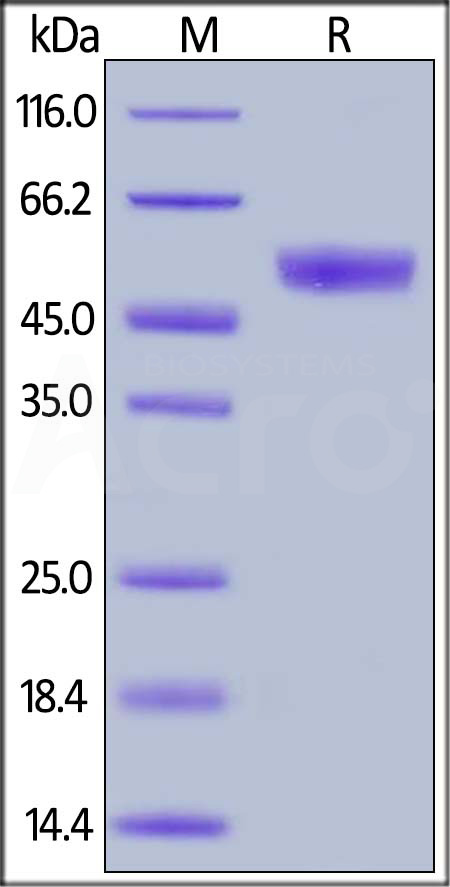HLA-E/peptide complexes differentially interact with NKG2A/CD94 and T cell receptorsVoogd, van den Broek, van Wolfswinkel
et alJ Immunol (2025)
Abstract: The virtually monomorphic antigen presentation molecule HLA-E can present self- and non-self peptides to the NKG2A/CD94 co-receptor inhibitory complex expressed on natural killer (NK) cells and to T cell receptors (TCRs) expressed on T cells. HLA-E presents self-peptides to NKG2A/CD94 to regulate tissue homeostasis, whereas HLA-E restricted T cells mediate regulatory and cytotoxic responses toward pathogen-infected cells. In this study, we directly compared HLA-E/peptide recognition and signaling between NKG2A/CD94 and 2 HLA-E restricted TCRs that can recognize self-peptides or identical peptide mimics from the viral UL40 protein of cytomegalovirus using position substituted peptide variants. We show that position 7 is critical for interaction with NKG2A/CD94, whereas position 8 is important for interaction with the TCRs. The Arginine at position 5 of these peptides is an essential residue for recognition by both receptors. Thus, NKG2A/CD94 and TCRs have different requirements for recognition of peptides presented in HLA-E.© The Author(s) 2025. Published by Oxford University Press on behalf of The American Association of Immunologists.
Tailoring Crystal Growth Regulation and Dual Passivation for Air-Processed Efficient Perovskite Solar CellsLi, Li, Li
et alAdv Sci (Weinh) (2025)
Abstract: Hybrid metal halide perovskite solar cells (PSCs) are emerging as highly competitive next-generation photovoltaics due to their excellent performance and low production cost. However, the construction of high-efficiency PSCs typically requires an inert nitrogen environment within a glove box, inadvertently increasing manufacturing costs and hindering the transition from lab-scale to industrial-scale production. In this work, an air ambient fabrication of pure α-phase FAPbI3 PSCs with high-efficiency and stability, utilizing a dual-functional engineering strategy assisted by 3-Guanidinopropionicacid (3-GuA) is reported. 3-GuA assists in managing excess PbI2 and promotes the formation of high-quality FAPbI3 films via intermolecular exchange. Simultaneously, the existence of 3-GuA minimizes the defects and stabilizes the resulting perovskite films. As a result, the ambient-air fabricated PSCs achieve a power conversion efficiency (PCE) of 24.2% with negligible hysteresis and excellent stability. Additionally, these devices demonstrate superior reproducibility, offering valuable guidance for future advancements in this technology.© 2024 The Author(s). Advanced Science published by Wiley‐VCH GmbH.
CD94-driven in vitro expansion of highly functional adaptive NKG2C+ NKG2A- CD57+ NK cells from CMV+ healthy donorsGiordano, Carlomagno, Falco
et alFront Immunol (2025) 16, 1481745
Abstract: Adaptive human natural killer (NK) cells are an NK cell subpopulation arising upon cytomegalovirus (CMV) infection. They are characterized by CD94/NKG2C expression, a mature CD57+KIR+NKG2A- phenotype, a prolonged lifespan, and remarkable antitumor functions. In light of these features, adaptive NK cells represent suitable candidate to design next-generation therapies, based on their enhanced effector function which could be further boosted by Chimeric Antigen Receptors-engineering, or the combination with cell engagers. For therapeutic approaches, however, it is key to generate large numbers of functional cells.We developed a method to efficiently expand adaptive NK cells from NK-enriched cell preparations derived from the peripheral blood of selected CMV-seropositive healthy donors. The method is based on the use of an anti-CD94 monoclonal antibody (mAb) combined with IL-2 or IL-15.By setting this method we were able to expand high numbers of NK cells showing the typical adaptive phenotype, CD94/NKG2C+ CD94/NKG2A- CD57+, and expressing a single self-inhibitory KIR. Expanded cells maintained the CMV-induced molecular signature, exhibited high ADCC capabilities and degranulation against a HLA-E+ target. Importantly, mAb-expanded adaptive NK cells did not upregulate PD-1 or other regulatory immune checkpoints that could dampen their function.By this study we provide hints to improve previous expansion methods, by eliminating the use of genetically modified cells as stimulators, and obtaining effectors not expressing unwanted inhibitory receptors. This new protocol for expanding functional adaptive NK cells is safe, cost-effective and easily implementable in a GMP context, suitable for innovative immunotherapeutic purposes.Copyright © 2025 Giordano, Carlomagno, Falco, Cantoni, Vitale, Caruana, Dirks, Serio, Muccio, Bartalucci, Bo, Locatelli, Bottino, Sivori and Della Chiesa.
Evidence for altered immune-structural cell crosstalk in cystic fibrosis revealed by single cell transcriptomicsBerg, Krabbendam, van der Ploeg
et alJ Cyst Fibros (2025)
Abstract: Chronic pulmonary inflammation strongly contributes to respiratory failure and mortality in patients with cystic fibrosis (pwCF). Effective anti-microbial immunity and maintaining lung homeostasis require continuous structural-immune cell communication. Whether and how this crosstalk is altered in CF remains poorly understood, obscuring potential new angles for therapy development to restore airway homeostasis in pwCF.We performed droplet-based single cell RNA-sequencing on bronchial biopsies from pwCF to investigate structural-immune cell crosstalk. Computational analyses were used to compare these data to samples obtained from healthy controls.CF airway wall biopsies showed lower proportions and altered transcriptomes of basal cells, submucosal gland cells and endothelial cells, and a higher abundance of ciliated cells, monocytes, macrophages and T cells. Both B and T lymphocytes displayed aberrantly activated phenotypes with transcriptional changes linked to hypoxia and vascular endothelial growth factor signaling, indicative of crosstalk with endothelial cells. The CF lung displayed unique changes in intercellular communication potential involving ionocytes, macrophages, endothelial cells and lymphocytes. This included interactions between HLA-E on structural cells and the druggable CD94/NKG2A immune checkpoint on CD8+T cells.We report the first single cell transcriptome atlas of the CF lung containing the full spectrum of structural and immune cells, providing a valuable resource for investigating changes to cellular composition, phenotypes and crosstalk linked to CF. Our analyses highlight dysregulated basal cell function and adaptive immunity in pwCF - despite favorable responses to CFTR modulator therapy. We identify novel aspects of CF pathophysiology and potential entry points for therapeutic strategies.Copyright © 2025 The Author(s). Published by Elsevier B.V. All rights reserved.

























































 膜杰作
膜杰作 Star Staining
Star Staining

















